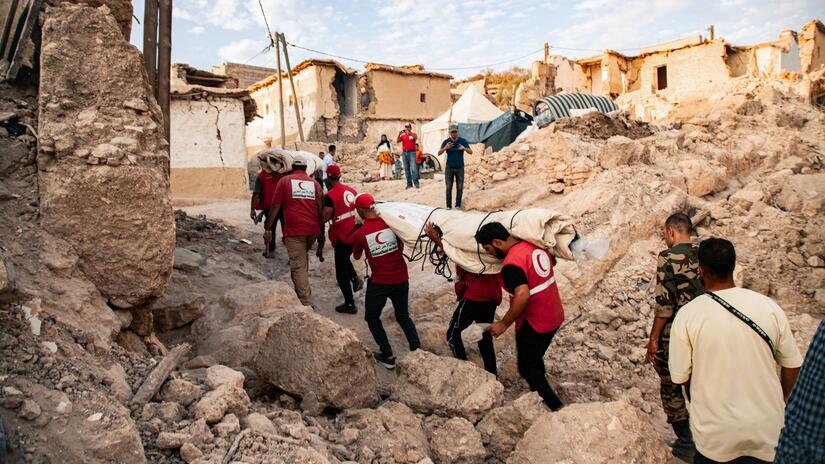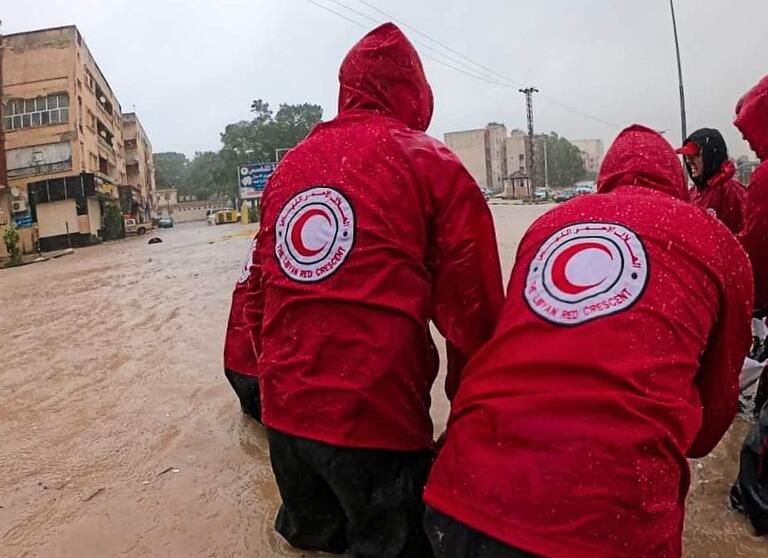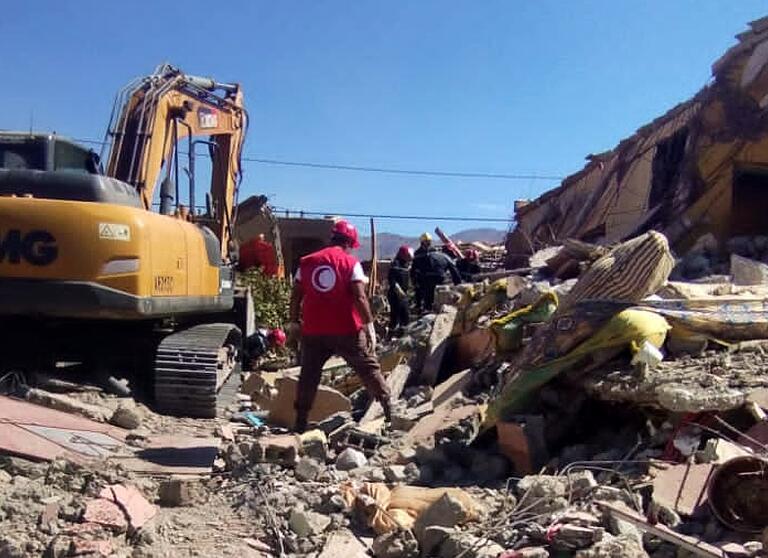Since the escalation of hostilities between Israel and Palestine in October 2023, the Egyptian Red Crescent has delivered nearly 18,000 truck loads of medical supplies, food, and other goods into Gaza. The Palestine Red Crescent Society, meanwhile, continues to provide emergency health services and coordinate the receipt and delivery of the aid.
The process has not always been smooth.
Aid deliveries were often blocked or delayed. But ultimately, thousands of shipments were able to get through. The Egyptian Red Crescent’s ability to scale up rapidly and respond effectively is largely due to its experience with supporting thousands of people who fled violence in neighboring Sudan.
“In the case of the Egyptian Red Crescent, there were many learnings taken from the response to the population movement from Sudan last April,” says Dr. Hosam Faysal, regional head of the IFRC’s Health, Disasters, Climate and Crises (HDCC) Unit in the MENA region. “The learnings were about what the logistics system requires in each case, and how to build it quickly and scale it according to the needs of the response”.
But the crisis today in the Middle East is also posing many new challenges, according to Lotfy S. Gheith, head of operations of the Egyptian Red Crescent Society.
“We are facing a very different crisis from previous ones,” Gheith says. “We are used to working in Gaza, but now the situation is unpredictable, and we do not know how situations can escalate from one moment to the next, as has been happening.
“This operation is a challenge, because we are sending trucks with humanitarian aid, which we have increased significantly. But it is not enough for the great, urgent needs of the population.”

Two members of the Egyptian Red Crescent operations team assess the inventory of aid that will be delivered into Gaza. Since the escalation of hostilities between Israel and Palestine in October 2023, the Egyptian Red Crescent has delivered nearly 18,000 truck loads of medical supplies, food, and other goods into Gaza.
Photo: Egyptian Red Crescent Society
The making of an emergency response
This is one side of the humanitarian equation that is often not told. It’s the story of what is done behind the scenes, before a crisis, to ensure the response is effective because it fits the local situation, culture and dynamics.
The Middle East and North Africa (MENA) region, renowned for its intricate geopolitical dynamics, vast and diverse areas and cultures, is also a region grappling with some of the world's most daunting humanitarian challenges.
MENA National Societies operate within this complex and ever-evolving context, navigating a wide range of challenges that span from civil unrest and violence to extreme weather — such as heatwaves, droughts and flooding — as well as technological hazards like the massive explosion that rocked Beirut in 2020.
Getting ready
None of this would be possible without prior preparation by the National Societies. In order to provide an effective response, National Societies need to work on their response mechanisms.
This means training staff and volunteers, going through simulations, building the capacity around contingency planning, as well as looking into learnings that can be gathered from other emergencies.
The Lebanese Red Cross, for example, has several overlapping crises to deal with: the consequences of the August 4, 2020 explosion, the internal economic crisis, the Syrian refugee crisis, and now the conflict in Gaza.
About this latest crisis, the National Society already had the mandate from the authorities to provide emergency medical services. The National Society could then improve its readiness by prepositioning stocks, increasing the alert level within their own Emergency Medical Services stations, and mobilizing more staff and volunteers to be ready for deployment.
“We saw how it paid off when the escalation started in the south and the Lebanese Red Cross was immediately ready to respond and provide support to the affected and displaced population,” says Faysal.
“[The Lebanese Red Cross] was indeed the only trusted entity to access the south to evacuate the wounded,” he adds. “All this has been possible through contingency planning, coordination, and the availability of resources”.
In the case of Syria, the National Society is developing different scenarios in the event of an escalation of the conflict. As the context in Syria is one of protracted crises, the Syrian Arab Red Crescent Society mainly envisions the work it will have to undertake in case there is a need to increase the evacuation of wounded or affected populations.
Its contingency plan includes protective measures for staff and volunteers when accessing risk areas, preparing to have more ambulances ready for evacuations, and carrying out more maintenance work to ensure the availability of these ambulances.
The Jordan Red Crescent , meanwhile, is aiming to prepare for the potential evacuation of wounded people from the West Bank to Jordan for medical treatment. The Jordan Red Crescent has its own hospital, so its aim is to enhance medical services in order to receive and accommodate those in need for treatment.

Training, preparation and investment before a disaster strikes are critical so that teams like this one — Libyan Red Crescent volunteers wading through waist-high water after a sudden flood in September 2023 — can save lives effectively and safely.
Photo: Libyan Red Crescent Society
A need for more investment
The MENA region has also been hit recently by several disasters, such as the earthquakes in Syria and Morocco, which left thousands of people dead and wreaked devastation in both countries.
In the case of Morocco, the National Society had been working for several years on preparedness activities, updating its contingency plans and conducting simulation exercises with local authorities, as well as having a very clear and defined contingency plan at the national level.
“The National Society has a well-defined and comprehensive contingency plan, and that's not something we see very often,” says Faysal. “It is very impressive. It includes coordination with other authorities and how to activate [the plan] at the national level”.
Nevertheless, it is still necessary to develop and maintain sustainable actions and resources to ensure that National Societies respond adequately to crises and disasters.
“In general, unfortunately, we see that in most cases resources only will be available when the emergency is in media headlines,”, Faysal adds.
In response to this concern, the IFRC developed a multi-year programme on earthquake preparedness for eight countries in the region, using a multi-hazard approach. But, says Faysal, they received no support from partners and donors.
“So, when the earthquake hit, we were in the same situation as we were in Syria [following the earthquake there in February 2023], with no considerations for us to be better prepared”, he says. “This is not about putting pressure on partners, because it's not just about resources, but also about availability and technical engagement.”
This is why it’s critical to continually highlight the need for preparation, behind the scenes, before disaster strikes. Krystell Santamaria, Disaster Risk Management Coordinator for IFRC MENA Region, puts it this way: “We must continue to invest in preparedness, to ensure that resources are sustainable: Preparedness efforts must be updated cyclically and maintained over time, to guarantee that National Societies can respond effectively to the growing crises in the Mena region. This is the challenge”.
By Olivia Acosta








